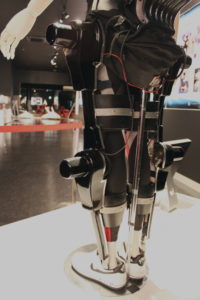
The world’s first advanced robotic treatment device that has been evidenced to improve a patient’s ability to walk is being made commercially available in the USA. Individuals with spinal cord injuries can now access FDA-cleared HAL, which is short for Hybrid Assistive Limb, at the Brooks Cybernic Treatment Center (Jacksonville, USA). The Treatment Center is currently the only facility in the USA offering this treatment.
Brooks Rehabilitation has partnered with the Japanese medical and social innovation company Cyberdyne to make HAL available.
Medical Director of the Brooks Cybernic Treatment Center, Geneva Tonuzi, comments, “We have already seen the results of improved mobility and ability to walk in patients with spinal cord injury at several international locations that are providing this technology. We are thrilled to finally have this unique technology available here at Brooks Rehabilitation as it opens the door to more research and treatment methods in advancing spinal cord injury treatment.”
Recently implemented in Japan, Germany and other countries, HAL fits to the patient’s lower limbs and trunk, and operates using internal signals from the body. This powered lower extremity exoskeleton is unique from any other exoskeleton treatment available today because the device’s movements are neurologically-controlled by the patient’s volition, and use of its secondary Biofeedback Device features allows the patient to see and adjust the signals they are producing. This functional integration of human neural pathways with modern technology is a landmark advancement for spinal cord injury patients nationwide.
Yoshiyuki Sankai (University of Tsukuba, Japan), president and CEO of Cyberdyne, and the visionary behind HAL, explains, “Wearing HAL leads to a fusion of human, robot, and information systems. I am pleased that cybernic technology will now benefit patients in the USA, helping to improve their walking ability as well as gain other functional and physiological benefits.”
How it works:
- Sensors attach to the patient’s lower extremities.
- When the patient intends to move, muscles receive nerve signals from the brain, and faint bioelectrical signals are detected on the skin’s surface.
- HAL uses sensors to detect these signals and assists with desired movements, while also enhancing strength and stability.
- Active use of neural pathways for voluntary movement with physical feedback to the brain leads to improved ability for the patient to walk on their own.
Patients who participate in HAL treatments at the Brooks Cybernic Treatment Center can also choose to share their treatment data for clinical research trials that further evaluate the effects of HAL interventions and future improvement opportunities.













I am suffering from spinalcord injury 16 year diagnosis d3 to d8 please give me suggestions sir l am walking with support of callipar and walker